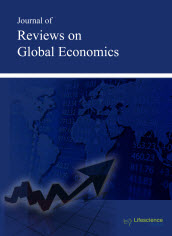jrge
Abstract - The “Sudden” Transition to the Free Floating Exchange Rate Regime in Russia in 2014
|
|
Abstract: The events of the fall of 2014 in the Russian currency market forced Bank of Russia to change the exchange rate regime in the national economy. In this study we show that in 2014 the regulator was trying to protect ruble (the Russian national currency) against a massive speculative attack, actively spending its international reserves, but the interventions proved quite ineffective. Moreover, the peculiarity of the structure of these reserves dictated a very limited range of maneuver for the central bank, forcing it to switch to the free floating exchange rate regime in the first half of November, 2014 – an important event, which, actually, could have been predicted by the lay experts on the basis of publically available information and application of simple econometric models. Noteworthy to say that, although not expectedly to the lay population, this switch of the exchange rate regime was done by Bank of Russia quite timely. Keywords: International reserves, adequacy rules, currency interventions, econometric modeling and forecasting. |
Abstract - Expectations, Taylor Rules and Liquidity Traps
|
|
Abstract: This paper includes three equilibrium paths (Christiano et al. 2011; Werning 2012; Cochrane 2016) that model liquidity traps in a unified framework with expectations of duration of the zero lower bound and expectations of a Taylor-type rule outside of the trap, and finds that their appearance depends on these expectations. Other than that, Werning (2012)’s and Cochrane (2016)’s equilibrium paths require one more strong assumption and are thus arguably harder to observe in reality although Cochrane (2016)’s equilibrium path fits the recent data better. Keywords: Liquidity traps, The zero lower bound, Equilibrium selection, Taylor rules. |
Abstract - Changes in Inflation Persistence Prior and Subsequent to the Subprime Crisis: What are the Implications for South Africa?
|
|
Abstract: The appropriateness of the inflation targeting regime as a policy framework for the South African Reserve Bank (SARB) continues to be a furiously debated topic for both academics and policymakers alike. In this study, we approach this debate by examining whether there have been any changes in the persistence of the inflation process for periods prior and subsequent to the global financial crisis. By effect, our study attempts to answer the question of whether inflation targets have been successful in controlling inflation rates in the face of unanticipated financial crisis. Indeed, our empirical results indicate that persistence in the inflation process has decreased in periods subsequent to the subprime crisis, and yet this has been accompanied by decreases in economic growth and unchanged high levels of unemployment. Our study ultimately suggests that given the current status of the economy, inflation may be required to be lowered to close-to-zero levels which will have to be accompanied with higher levels of economic growth, separate macroeconomic policies which specifically target unemployment and a change in domestic real interest rates. Keywords: Inflation persistence, inflation targeting, global financial crisis, monetary policy, South Africa, sub-Saharan Africa (SSA). |
Abstract - Correlations between the Market Price of Interest Rate Risk and Bond Yields
|
|
Abstract: This paper examines empirical properties of the market price of interest rate risk, focusing on the relation between the price and interest rates. We briefly summarize how the market price of risk is estimated, and introduce the positive slope model to explain our empirical observation. The market price of risk is estimated for the U.S. Treasury market, 1970-2014, using the Hull–White model. We test the correlation between the market price of interest rate risk and bond yields. The results are that the yield change and term spreads are significantly correlated with the market price of risk, but the initial yields are not correlated with that. These results are theoretically interpreted by a mathematical model, and serve as a valuable reference for risk management as well as for study of financial policy. . Keywords: Correlation analysis, Financial policy-making, Hull–White model, Interest rate model, Interest-rate-risk management, Market price of risk, Potential future exposure, Risk premium, Solvency risk, U.S. Treasury yields. |






















